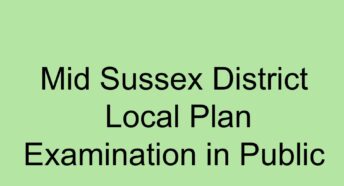Mid Sussex District Update February 2024
Report on CPRE Sussex activities in Mid Sussex District July 2023 – February 2024.
I am afraid that we are a little late in our six monthly reporting to you. We wanted to be able to brief you on our conclusions on the District Plan Review proposals that Mid Sussex District Council (MSDC) intends to submit for examination to the Planning Inspectorate and our submission to MSDC in respect of those updated Plan proposals. This is probably the most important exercise that we undertake when their District Plan gets updated (as it has to be every five years), as it affects every Mid Sussex resident and business for the foreseeable future. Here is a summary of the views we have expressed to the Council.
Mid Sussex District Plan Review:
The Plan carries the power of endorsement from all but one of the voting Councillors of all political persuasions represented on the Council.
But does that make it the right Plan? It has certainly been improved and become greener since its predecessor version on which the Council consulted in late 2022. We are grateful to see that our pleas for tougher new home energy standards have been recognised, for example. The Plan contains other needed and welcome green policies, (though why is there no water pollution policy or target for increasing the delivery of rooftop solar panels?).
Overall, though, we are disappointed that the Council’s Plan is not more ambitious, and that we residents have been almost entirely shut out of the process of developing it in a way that works best for the long-term future of the District that we all cherish.
We are disappointed that the Council has been too timid in its approach to setting its housing target: the Plan seeks to deliver far more houses than the Council itself believes are needed, and is therefore lining up future greenfield housing sites for allocation that are neither required nor sustainable. Other Sussex councils are taking a more proactive approach to marrying their housing target to their real local need.
We are particularly disappointed that the Council does not propose a much more ambitious affordable homes policy, especially as the Council acknowledges that its current policy is not meeting the District’s existing needs. The country faces a housing crisis. That crisis is primarily a crisis of affordability rather than of number. Affordable housing provision should be a core Council priority. The affordability crisis will never be solved simply by building more market housing. More and more people have abandoned the aspiration of owning their own home. We believe that Mid Sussex DC has the headroom to deliver far more affordable houses and first homes than it is aiming for, and that this should be a key Plan priority. Again, other Sussex councils have more ambitious plans than this Council.
It is shocking, too, that not one of the strategic significant sites proposed by the Council is on brownfield, whilst the largest single brownfield site in Mid Sussex, the Martlets Centre in Burgess Hill continues to sit there, a blight on the town.
Instead, MSDC intends to allocate a number of land parcels on open land between Sayers Common and Albourne for the development of what they call a 20 minute neighbourhood of 2,500 homes there (meaning a community that delivers most of the facilities and services within a 20 minute walking radius, thereby largely eliminating car dependency). We say that it is wishful thinking on the Council’s part to believe that they can deliver a self-sustaining 20 minute community in such a rural setting, so we have opposed these allocations. If it isn’t sustainable, don’t develop it. And if only the Plan set a realistic housing target, they wouldn’t need to.
The Plan’s focus on pushing so much of the required new housing into the Low Weald has highlighted for us the need for the Plan to include a policy spelling out how the balance is to be managed between its conservation as a rural jewel in the area’s countryside crown and the limited development that the Downland villages need to maintain their vitality as individual communities. It is paradoxical that the High Weald, already protected from overdevelopment by law, is also the subject of a detailed Plan policy, whilst the Low Weald, being undesignated from an environmental standpoint, has no protective policy, even though it is in real danger of becoming a developers’ play-pit. We want the Plan to fill that gap.
Our submission to the Council includes a number of other suggestions that we argue will strengthen the Plan’s soundness, all of which we believe to be uncontroversial to anyone with an open mind.
We will be asking to be able to participate in the Plan examination later this year, so that we can suggest to the Inspector how the soundness of MSDC’s proposals can be further strengthened along these lines.
You can read our full submission to MSDC on their Plan Review on our website here: www.cpresussex.org.uk/mid-sussex/
Ansty Farm planning application
This is a pastoral site of some 250 acres between Cuckfield and Ansty village on which a developer has applied for planning permission to build 1,400 new homes. As with the proposed Sayers Common allocations mentioned above, the location is completely unsustainable for such a large development, with residents being utterly car dependent. We regard the planning application as a speculative one that is designed to disrupt the District Plan Review allocation process and force this site onto the agenda as a site that should be allocated for housing as part of the new Plan. We have written to the Council encouraging them to reject the application.
Working with the two involved parish councils and a local action group we continue fighting to protect this site and to resist any attempt at the District Plan Review examination to get it allocated for development.
Getting our voices heard
National planning policy expects local planning authorities to develop their strategic plans on a basis that is ‘shaped by early, proportionate and effective engagement between plan-makers and communities, local organisations’ etc. That is not the way in which this draft Plan Review has reached this final stage. Comments from us and others now are, in effect, objections to a Plan that is already settled in the Council’s mind, not (as we would wish) ideas to shape it. Its strategy and policies have been devised behind closed doors. That is not how it should be, and it is not what more proactive planning authorities do.
The District Plan Review is a weaker plan in its current form because it has missed out on the input of those of us who live and work here and have ideas to make it work for our communities. The people affected by this new Plan ought to feel that they own the Plan and that they want to help make its policies work. Instead, they face a plan that is being imposed upon them. It should not be this way. It did not need to be this way.




